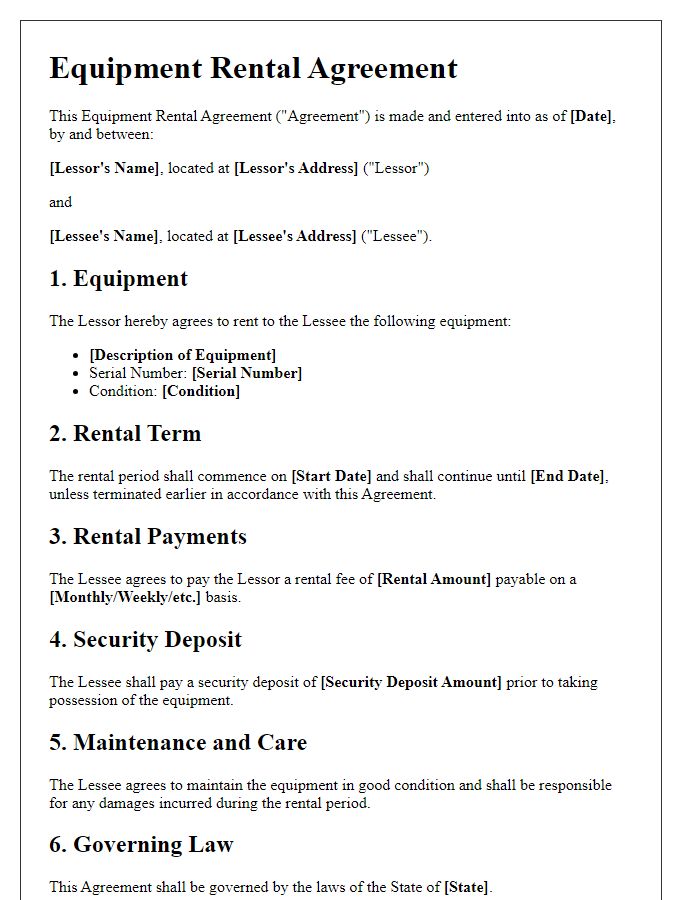Are you looking to rent equipment for your next construction project? Crafting a clear and effective rental agreement is essential to ensure that both parties know their rights and responsibilities. In this article, we will guide you through creating a comprehensive letter template for your contractor equipment rental agreement, highlighting all the key elements you need to consider. So, let's dive in and help you make your rental process smooth and hassle-free!

Parties Involved and Contact Information
A contractor equipment rental agreement involves multiple parties, typically including the rental company, often referred to as the lessor, and the contractor, known as the lessee. The lessor must provide comprehensive contact information, including the company's legal name, address, phone number, and email address for effective communication. The lessee should likewise include their legal entity name, primary business address, and relevant contact details to facilitate prompt correspondence regarding equipment specifications and rental terms. Accurate identification of both parties is essential to establish a clear legal framework for the rental transaction, ensuring accountability and clarity of responsibilities within the agreement.
Equipment Description and Specifications
The equipment rental agreement outlines various types of machinery and tools available for rent, emphasizing critical specifications such as horsepower, weight, and operational efficiency. For example, a hydraulic excavator may have a digging depth of 25 feet and a bucket capacity of 0.5 cubic yards, making it ideal for construction sites in urban areas like New York City. Compact models, such as the mini excavator, often weigh around 4,500 pounds, allowing for usage in tighter spaces without causing damage to surrounding infrastructure. Additionally, included attachments, like a breaker or auger, enhance versatility, enabling the equipment to perform various tasks crucial for projects in landscaping or utility excavations. Clear documentation of service history and maintenance records is essential to ensure safety and reliability during the rental period.
Rental Duration and Payment Terms
When renting contractor equipment, clearly defined rental duration and payment terms are essential for both parties. The rental duration typically specifies the start date, often a specific day in a month, and the end date, usually a predetermined number of days (e.g., 30 days, 6 months). Payment terms should include the rental fee amount, due dates, and options for payment methods, such as credit card, bank transfer, or check. It may also outline any late payment penalties or discounts for early payment. Additionally, it is crucial to specify the conditions for deposit refunds upon equipment return after the rental duration, ensuring both parties understand their financial responsibilities thoroughly.
Maintenance, Damages, and Liabilities
Equipment rental agreements include critical terms regarding maintenance, damages, and liabilities associated with machinery. Regular maintenance must be outlined, specifying schedule intervals (monthly or quarterly) for the maintenance of heavy machinery like excavators and bulldozers. Rental service providers should clarify responsibilities for damage incurred during rental periods, including wear and tear assessments. For instance, if a rented crane is damaged beyond normal usage, liability limits must be defined, potentially referencing insurance coverage amounts, such as $1 million general liability insurance. Additionally, indemnification clauses must specify financial responsibilities for both the contractor and the rental company in scenarios involving accidents or third-party injuries, ensuring a clear understanding of potential legal liabilities arising from equipment use on construction sites or industrial projects.
Termination, Renewal, and Governing Law
The termination of a contractor equipment rental agreement occurs under defined conditions, such as non-payment or breach of contract. Tenants must provide written notice (typically 30 days) prior to termination. Renewal options may be available, contingent upon mutual consent, with rental rates possibly adjusted based on market conditions or extended usage durations. The governing law applicable is usually the jurisdiction where the rental transaction takes place, ensuring compliance with local regulations and dispute resolutions according to the respective state laws, such as those in California or New York, which possess specific rental guidelines.
Letter Template For Contractor Equipment Rental Agreement Samples
Letter template of contractor equipment rental agreement for short-term projects

Letter template of contractor equipment rental agreement for long-term rentals

Letter template of contractor equipment rental agreement with maintenance clauses

Letter template of contractor equipment rental agreement for construction machinery

Letter template of contractor equipment rental agreement for landscaping tools

Letter template of contractor equipment rental agreement with insurance requirements

Letter template of contractor equipment rental agreement for heavy-duty equipment

Letter template of contractor equipment rental agreement including pricing structure

Letter template of contractor equipment rental agreement for commercial use





Comments